Effect of Glycine on the Wet Carbonation of Steel Slag Used as a Cementitious Material
Abstract
1. Introduction
2. Materials and Methods
2.1. Materials
2.2. Methods
2.2.1. Wet Carbonation of SS
2.2.2. Preparation of Carbonated SS–Cement Cementitious Material
2.3. Multicycle Carbonation Experiment
3. Results and Discussion
3.1. Reaction and Mechanism during Carbonation of SS with Glycine
3.2. XRD Analysis of Carbonated SS
3.3. TG–DTG Analysis of Carbonated SS
3.4. Utilization of Carbonated SS in SS–Cement Cementitious Materials
3.4.1. Compressive Strength of SS–Cement Cementitious Materials
3.4.2. Soundness of SS–Cement Cementitious Materials
3.5. Multiple Cycles of Wet Carbonation of SS with Glycine
4. Conclusions
- The addition of glycine facilitates the carbonation process of SS and the carbonation efficiency is increased. The carbonation degree of SS improves with increasing glycine additions. When the concentration of glycine is 0.25 mol/L and the carbonation time is 1 h, the CO2 sequestration rate of SS is 9.42%, while for the sample without glycine, it was 7.189%. The carbonation products are mainly calcium carbonate with crystal-type calcite.
- After carbonation treatment, the expansive-phase f-CaO is reacted and convert into thermodynamically stable carbonate products, thus the soundness of SS is efficiently improved. The 28-day compressive strength of the cementitious material that contained carbonated SS with glycine was improved compared to the sample that contained uncarbonated SS. The maximum increase was 8.48%.
- Glycine promotes the carbonation process of SS and can be reused during successive wet carbonation of SS. Multicycle experiments via solvent recovery demonstrated that although the promotional effect of glycine was reduced after each cycle, compared with the SS–water system, the carbonation process was still facilitated. The carbonated SS obtained from each experiment contains calcite as a carbonation product and the f-CaO in the SS was effectively eliminated.
Author Contributions
Funding
Institutional Review Board Statement
Informed Consent Statement
Data Availability Statement
Conflicts of Interest
References
- Prateek, G.; Zheng, K.; Gong, C.; Wei, S.; Zhou, X.; Yuan, Q. Preparing high strength cementitious materials with high proportion of steel slag through reverse filling approach. Constr. Build. Mater. 2023, 368, 130474. [Google Scholar] [CrossRef]
- Li, H.; Cui, C.; Sheng, Y.; Zhang, M.; Feng, Z.; Li, L.; Xue, H.; Zhang, Y. Application of composite steel slag as subgrade Filler: Performance evaluation and enhancement. Constr. Build. Mater. 2023, 370, 130448. [Google Scholar] [CrossRef]
- Chandel, S.S.; Singh, P.K.; Katiyar, P.K.; Randhawa, N.S. A Review on Environmental Concerns and Technological Innovations for the Valorization of Steel Industry Slag. Min. Metall. Explor. 2023, 40, 2059–2086. [Google Scholar] [CrossRef]
- Van Ho, Q.; Huynh, T.-P. A comprehensive investigation on the impacts of steel slag aggregate on characteristics of high-performance concrete incorporating industrial by-products. J. Build. Eng. 2023, 80, 107982. [Google Scholar] [CrossRef]
- Nunes, V.A.; Borges, P.H.R. Recent advances in the reuse of steel slags and future perspectives as binder and aggregate for alkali-activated materials. Constr. Build. Mater. 2021, 281, 122605. [Google Scholar] [CrossRef]
- Kurniati, E.O.; Pederson, F.; Kim, H.-J. Application of steel slags, ferronickel slags, and copper mining waste as construction materials: A review. Resour. Conserv. Recycl. 2023, 198, 107175. [Google Scholar] [CrossRef]
- Li, N.; Unluer, C. Development of high-volume steel slag as cementitious material by ethylenediamine tetraacetic acid induced accelerated carbonation. Powder Technol. 2023, 428, 118899. [Google Scholar] [CrossRef]
- Carvalho, V.R.; Costa, L.C.B.; da Fonseca Elói, F.P.; da Silva Bezerra, A.C.; de Carvalho, J.M.F.; Peixoto, R.A.F. Performance of low-energy steel slag powders as supplementary cementitious materials. Constr. Build. Mater. 2023, 392, 131888. [Google Scholar] [CrossRef]
- Brand, A.S.; Roesler, J.R. Steel furnace slag aggregate expansion and hardened concrete properties. Cem. Concr. Compos. 2015, 60, 1–9. [Google Scholar] [CrossRef]
- Zajac, M.; Maruyama, I.; Iizuka, A.; Skibsted, J. Enforced carbonation of cementitious materials. Cem. Concr. Res. 2023, 174, 107285. [Google Scholar] [CrossRef]
- Srivastava, S.; Cerutti, M.; Nguyen, H.; Carvelli, V.; Kinnunen, P.; Illikainen, M. Carbonated steel slags as supplementary cementitious materials: Reaction kinetics and phase evolution. Cem. Concr. Compos. 2023, 142, 105213. [Google Scholar] [CrossRef]
- Elyasi Gomari, K.; Rezaei Gomari, S.; Hughes, D.; Ahmed, T. Exploring the potential of steel slag waste for carbon sequestration through mineral carbonation: A comparative study of blast-furnace slag and ladle slag. J. Environ. Manag. 2023, 351, 119835. [Google Scholar] [CrossRef]
- Humbert, P.S.; Castro-Gomes, J. CO2 activated steel slag-based materials: A review. J. Clean. Prod. 2019, 208, 448–457. [Google Scholar] [CrossRef]
- Ferrara, G.; Belli, A.; Keulen, A.; Tulliani, J.-M.; Palmero, P. Testing procedures for CO2 uptake assessment of accelerated carbonation products: Experimental application on basic oxygen furnace steel slag samples. Constr. Build. Mater. 2023, 406, 133384. [Google Scholar] [CrossRef]
- Kim, M.J.; Jung, S. Calcium elution from cement kiln dust using chelating agents, and CO2 storage and CaCO3 production through carbonation. Environ. Sci. Pollut. Res. Int. 2020, 27, 20490–20499. [Google Scholar] [CrossRef] [PubMed]
- Wang, J.; Watanabe, N.; Inomoto, K.; Kamitakahara, M.; Nakamura, K.; Komai, T.; Tsuchiya, N. Sustainable process for enhanced CO2 mineralization of calcium silicates using a recyclable chelating agent under alkaline conditions. J. Environ. Chem. Eng. 2022, 10, 107055. [Google Scholar] [CrossRef]
- Kunzler, C.; Alves, N.; Pereira, E.; Nienczewski, J.; Ligabue, R.; Einloft, S.; Dullius, J. CO2 storage with indirect carbonation using industrial waste. Energy Procedia 2011, 4, 1010–1017. [Google Scholar] [CrossRef]
- Pallav, V.; Teppand, T.; Leinpuu, A.; Shanskiy, M.; Mets, M.; Mändar, H.; Rikmann, E.; Liiv, J. Stabilization of Road Embankments on Peat Soils Using Oil Shale Ash and Pozzolanic Additives. Appl. Sci. 2023, 13, 8366. [Google Scholar] [CrossRef]
- Ji, L.; Yu, H.; Yu, B.; Jiang, K.; Grigore, M.; Wang, X.; Zhao, S.; Li, K. Integrated absorption–mineralisation for energy-efficient CO2 sequestration: Reaction mechanism and feasibility of using fly ash as a feedstock. Chem. Eng. J. 2018, 352, 151–162. [Google Scholar] [CrossRef]
- Hong, S.; Sim, G.; Moon, S.; Park, Y. Low-Temperature Regeneration of Amines Integrated with Production of Structure-Controlled Calcium Carbonates for Combined CO2 Capture and Utilization. Energy Fuels 2020, 34, 3532–3539. [Google Scholar] [CrossRef]
- Ji, L.; Zheng, X.; Ren, Y.; Wang, Y.; Wang, Y.; Yan, S. CO2 sequestration and recovery of high-purity CaCO3 from bottom ash of masson pine combustion using a multifunctional reagent—Amino acid. Sep. Purif. Technol. 2024, 329, 125171. [Google Scholar] [CrossRef]
- Kim, M.-J.; Jeon, J. Effects of Ca-ligand stability constant and chelating agent concentration on the CO2 storage using paper sludge ash and chelating agent. J. CO2 Util. 2020, 40, 101202. [Google Scholar] [CrossRef]
- Fei, Z.; Bao, Q.; Zheng, X.; Zhang, L.; Wang, X.; Wei, Y.; Yan, S.; Ji, L. Glycinate-looping process for efficient biogas upgrading and phytotoxicity reduction of alkaline ashes. J. Clean. Prod. 2022, 338, 130565. [Google Scholar] [CrossRef]
- Kim, M.-J.; Jung, S. Conditions required for multiple reuses of solvents in indirect carbonation. J. CO2 Util. 2020, 42, 101306. [Google Scholar] [CrossRef]
- GB/T 17671-2021; Test Method of Cement Mortar Strength (ISO Method). State Administration for Market Regulation/Standardization Administration of China. China Standard Publishing House: Beijing, China, 2021.
- GB/T 1346-2011; Test Method for Water Requirement of Normal Consistency, Setting Time and Soundness of the Portland Cements. General Administration of Quality Supervision, Inspection and Quarantine/Standardization Administration of China. China Standard Publishing House: Beijing, China, 2011.
- Wang, J.; Zhong, M.; Wu, P.; Wen, S.; Huang, L.; Ning, P. A Review of the Application of Steel Slag in CO2 Fixation. ChemBioEng Rev. 2021, 8, 189–199. [Google Scholar] [CrossRef]
- Zheng, X.; Liu, J.; Wei, Y.; Li, K.; Yu, H.; Wang, X.; Ji, L.; Yan, S. Glycine-mediated leaching-mineralization cycle for CO2 sequestration and CaCO3 production from coal fly ash: Dual functions of glycine as a proton donor and receptor. Chem. Eng. J. 2022, 440, 135900. [Google Scholar] [CrossRef]
- Liu, M.; Gadikota, G. Single-step, low temperature and integrated CO2 capture and conversion using sodium glycinate to produce calcium carbonate. Fuel 2020, 275, 117887. [Google Scholar] [CrossRef]
- Zheng, X.; Zhang, L.; Feng, L.; He, Q.; Ji, L.; Yan, S. Insights into dual functions of amino acid salts as CO2 carriers and CaCO3 regulators for integrated CO2 absorption and mineralisation. J. CO2 Util. 2021, 48, 101531. [Google Scholar] [CrossRef]
- Yin, T.; Yin, S.; Srivastava, A.; Gadikota, G. Regenerable solvents mediate accelerated low temperature CO2 capture and carbon mineralization of ash and nano-scale calcium carbonate formation. Resour. Conserv. Recycl. 2022, 180, 106209. [Google Scholar] [CrossRef]
- Ma, M.; Mehdizadeh, H.; Guo, M.-Z.; Ling, T.-C. Effect of direct carbonation routes of basic oxygen furnace slag (BOFS) on strength and hydration of blended cement paste. Constr. Build. Mater. 2021, 304, 124628. [Google Scholar] [CrossRef]
- Li, Y.; Mehdizadeh, H.; Mo, K.H.; Ling, T.-C. Co-utilization of aqueous carbonated basic oxygen furnace slag (BOFS) and carbonated filtrate in cement pastes considering reaction duration effect. Cem. Concr. Compos. 2023, 138, 104988. [Google Scholar] [CrossRef]
- Snehal, K.; Das, B.B.; Barbhuiya, S. Synergistic effect of nano silica on carbonation resistance of multi-blended cementitious mortar. Cem. Concr. Compos. 2023, 141, 105125. [Google Scholar] [CrossRef]
- Wang, X.; Ni, W.; Li, J.; Zhang, S.; Li, K. Study on Mineral Compositions of Direct Carbonated Steel Slag by QXRD, TG, FTIR, and XPS. Energies 2021, 14, 4489. [Google Scholar] [CrossRef]
- Shen, P.; Zhang, Y.; Jiang, Y.; Zhan, B.; Lu, J.; Zhang, S.; Xuan, D.; Poon, C.S. Phase assemblance evolution during wet carbonation of recycled concrete fines. Cem. Concr. Res. 2022, 154, 106733. [Google Scholar] [CrossRef]
- Martins, A.C.P.; de Carvalho, J.M.F.; do Nascimento Duarte, M.; de Lima, G.E.S.; Pedroti, L.G.; Peixoto, R.A.F. Influence of a LAS-based modifying admixture on cement-based composites containing steel slag powder. J. Build. Eng. 2022, 53, 104517. [Google Scholar] [CrossRef]
- Liu, P.; Mo, L.; Zhang, Z. Effects of carbonation degree on the hydration reactivity of steel slag in cement-based materials. Constr. Build. Mater. 2023, 370, 130653. [Google Scholar] [CrossRef]
- Wang, D.; Shi, C.; Farzadnia, N.; Shi, Z.; Jia, H. A review on effects of limestone powder on the properties of concrete. Constr. Build. Mater. 2018, 192, 153–166. [Google Scholar] [CrossRef]
- Han, F.; Zhang, Z.; Wang, D.; Yan, P. Hydration heat evolution and kinetics of blended cement containing steel slag at different temperatures. Thermochim. Acta 2015, 605, 43–51. [Google Scholar] [CrossRef]
- Chen, K.-W.; Pan, S.-Y.; Chen, C.-T.; Chen, Y.-H.; Chiang, P.-C. High-gravity carbonation of basic oxygen furnace slag for CO2 fixation and utilization in blended cement. J. Clean. Prod. 2016, 124, 350–360. [Google Scholar] [CrossRef]
- Antoni, M.; Rossen, J.; Martirena, F.; Scrivener, K. Cement substitution by a combination of metakaolin and limestone. Cem. Concr. Res. 2012, 42, 1579–1589. [Google Scholar] [CrossRef]
- Merlo, V.; Marchese, L.; Gastaldi, D.; Boccaleri, E.; Canonico, F.; Paul, G. Investigating the hydration of C3A in the combined presence of anhydrite and limestone using solid-state NMR, XRD and TG techniques. Constr. Build. Mater. 2023, 378, 131028. [Google Scholar] [CrossRef]
- Zajac, M.; Rossberg, A.; Le Saout, G.; Lothenbach, B. Influence of limestone and anhydrite on the hydration of Portland cements. Cem. Concr. Compos. 2014, 46, 99–108. [Google Scholar] [CrossRef]
- Moon, G.D.; Oh, S.; Jung, S.H.; Choi, Y.C. Effects of the fineness of limestone powder and cement on the hydration and strength development of PLC concrete. Constr. Build. Mater. 2017, 135, 129–136. [Google Scholar] [CrossRef]
- Zhou, Z.; Sofi, M.; Lumantarna, E.; San Nicolas, R.; Hadi Kusuma, G.; Mendis, P. Strength Development and Thermogravimetric Investigation of High-Volume Fly Ash Binders. Materials 2019, 12, 3344. [Google Scholar] [CrossRef]
- Martins, A.C.P.; Franco de Carvalho, J.M.; Costa, L.C.B.; Andrade, H.D.; de Melo, T.V.; Ribeiro, J.C.L.; Pedroti, L.G.; Peixoto, R.A.F. Steel slags in cement-based composites: An ultimate review on characterization, applications and performance. Constr. Build. Mater. 2021, 291, 123265. [Google Scholar] [CrossRef]


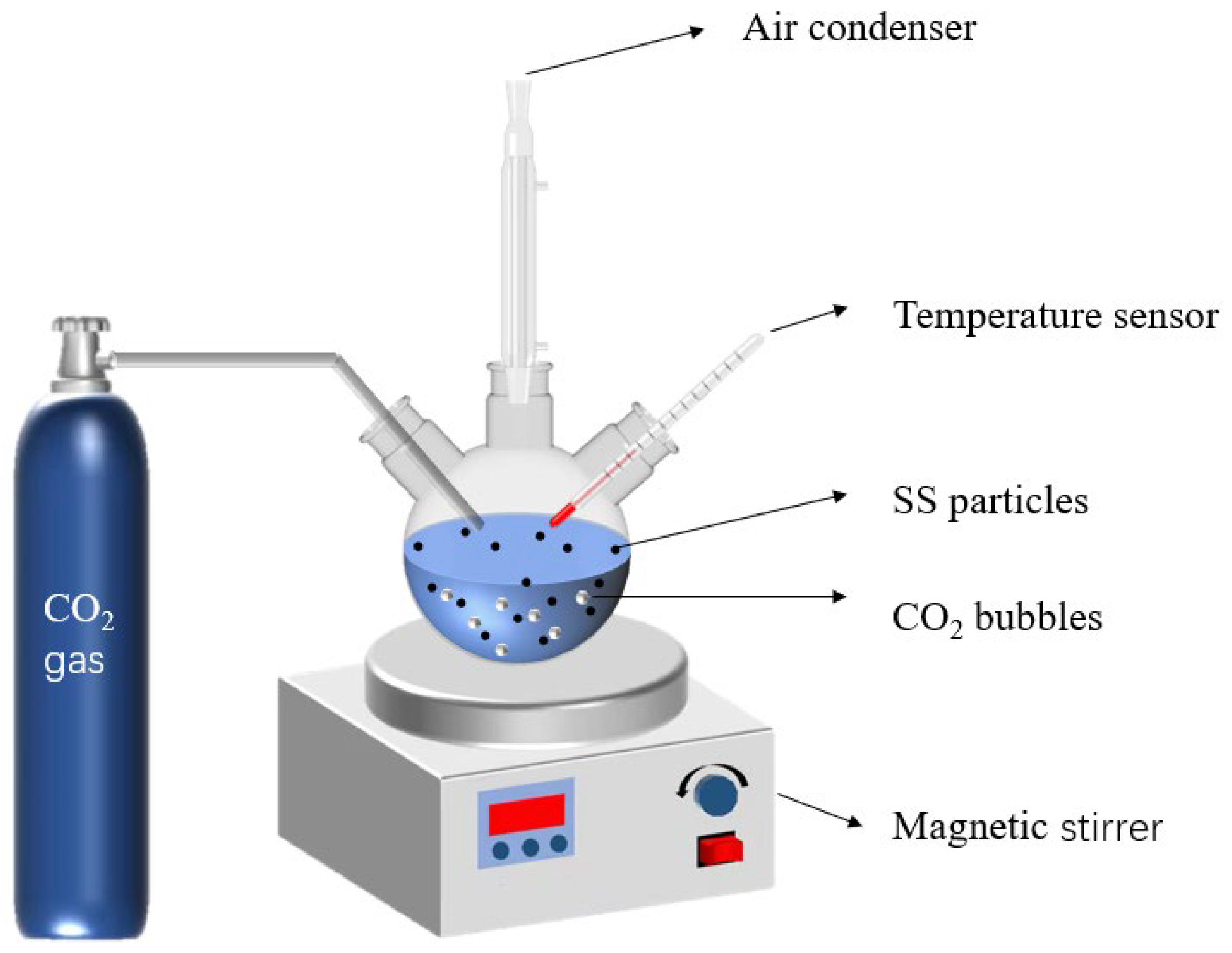
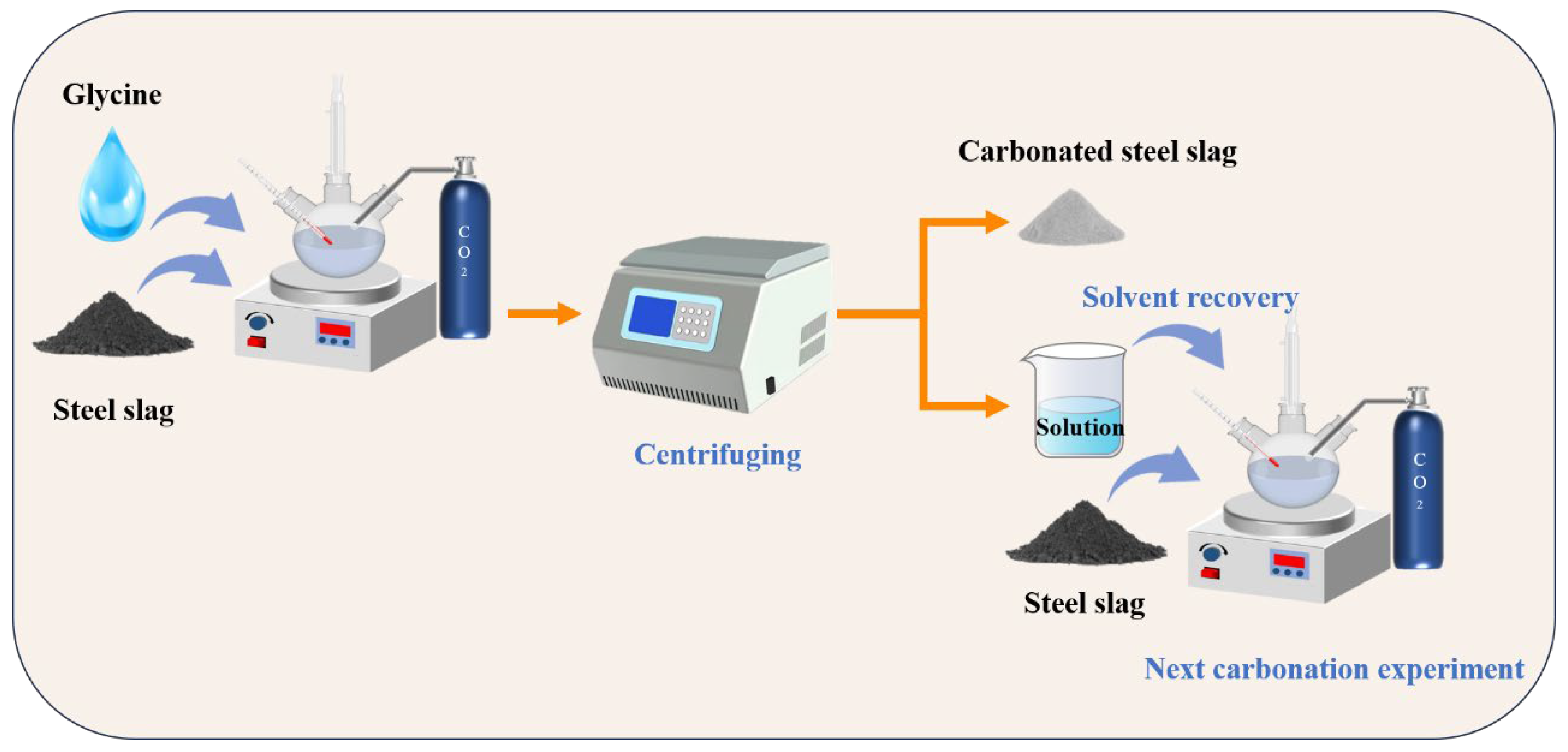
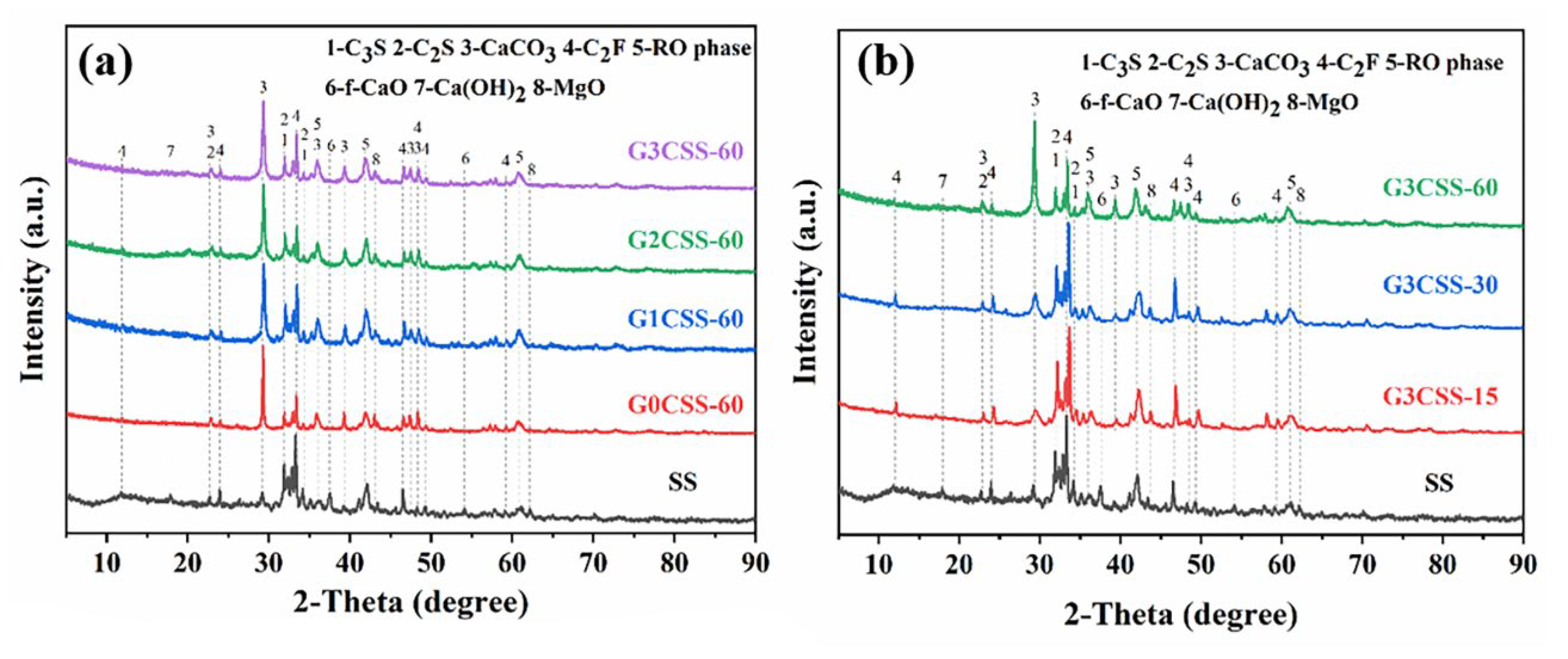

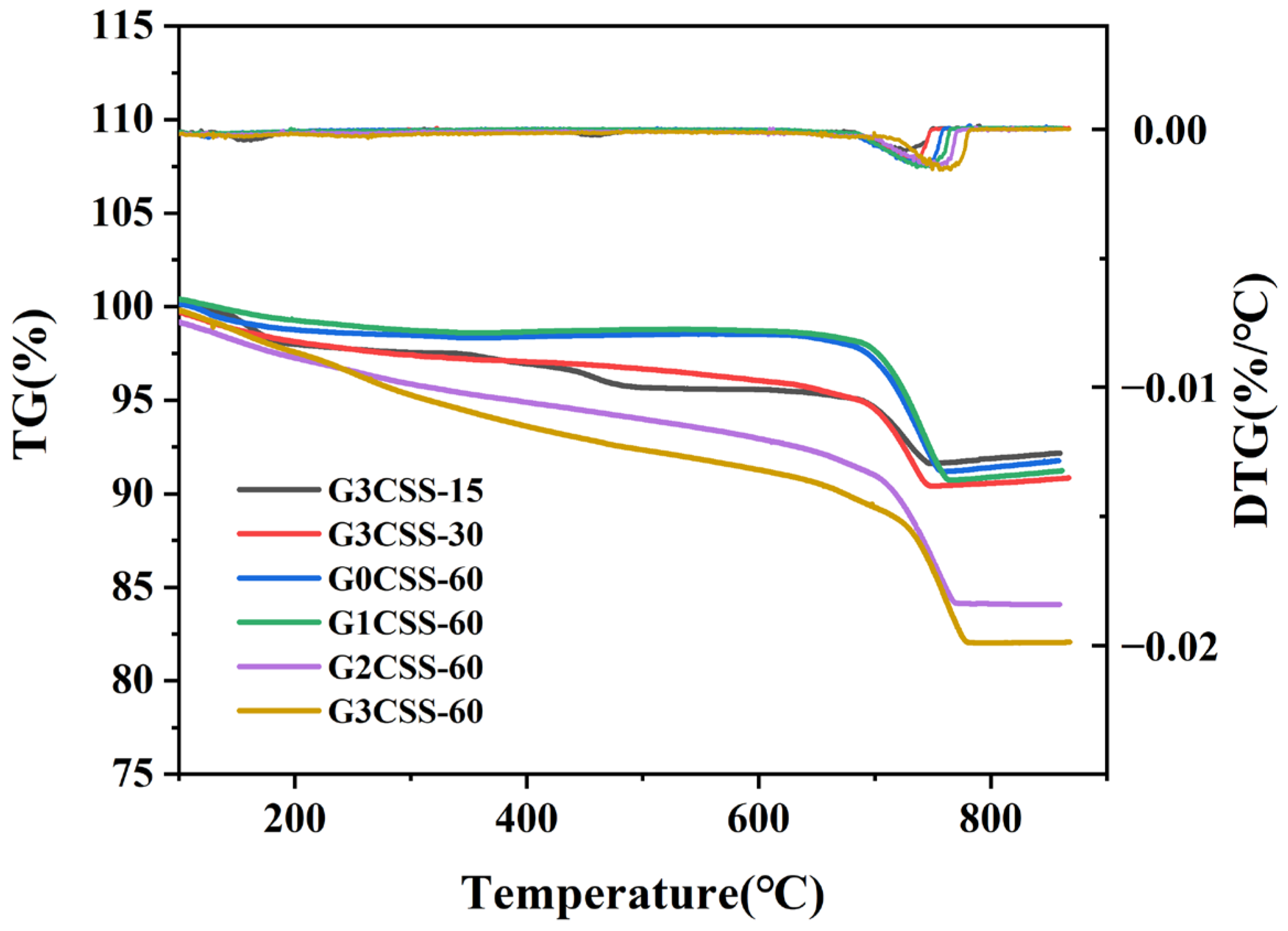


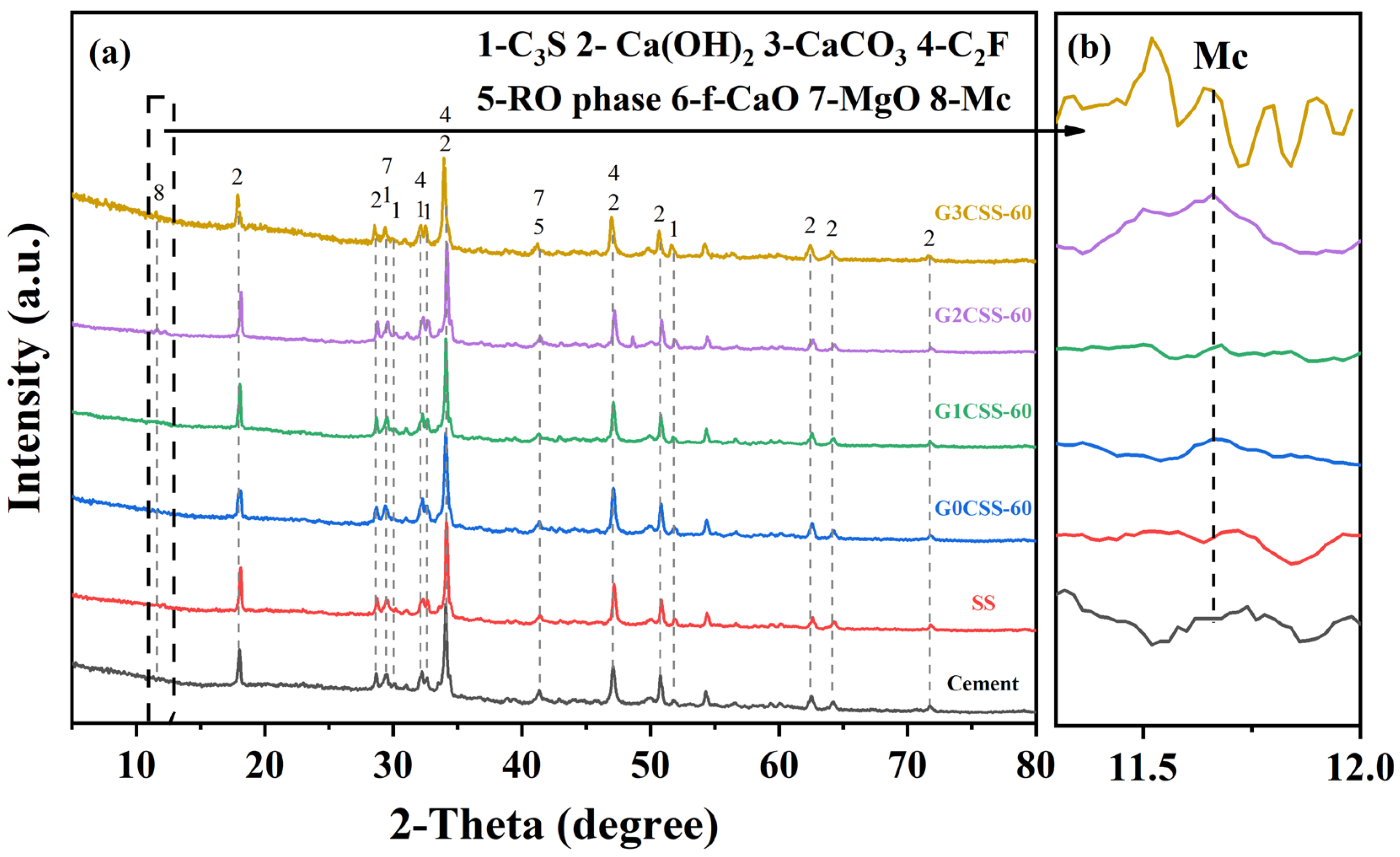

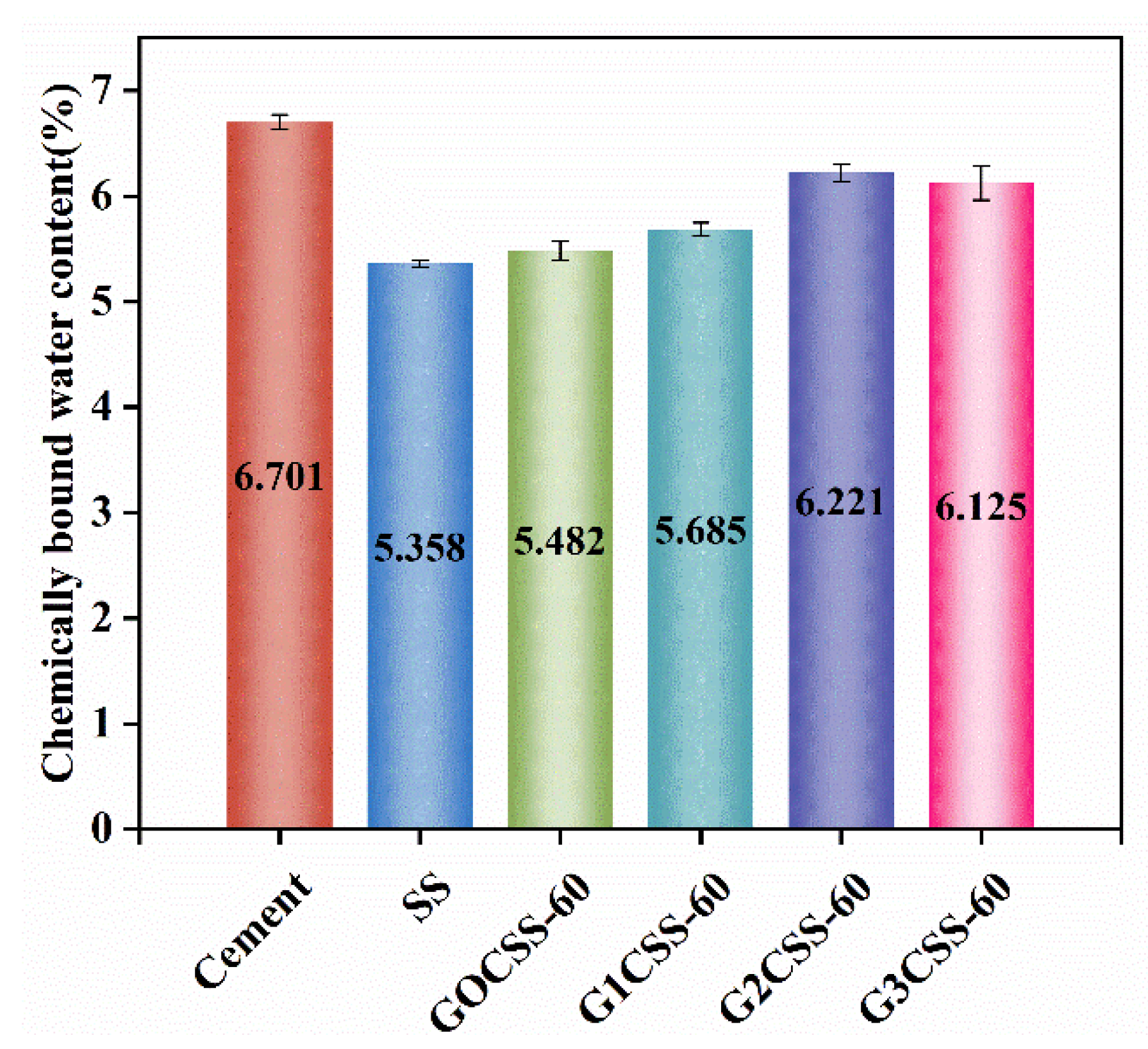
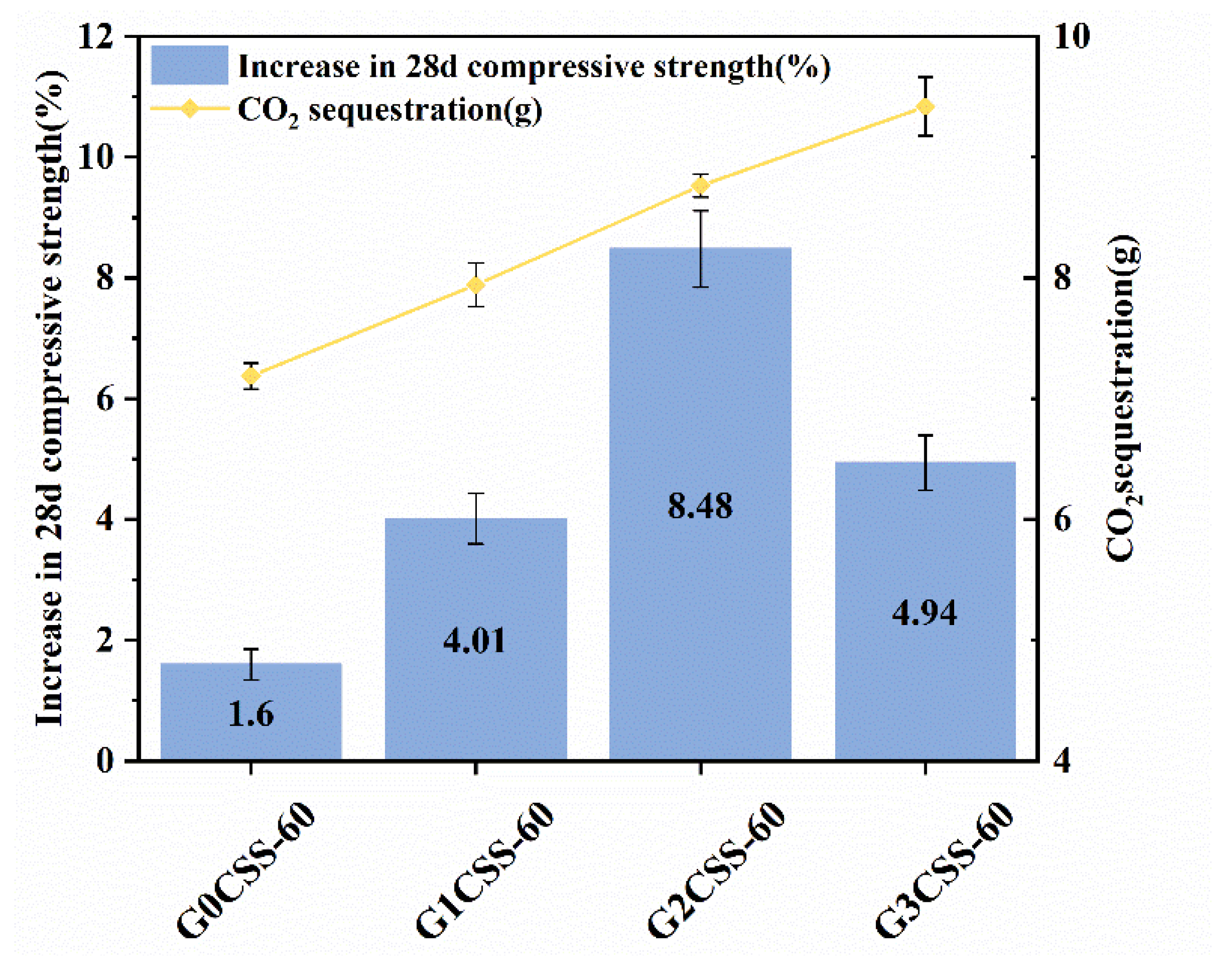

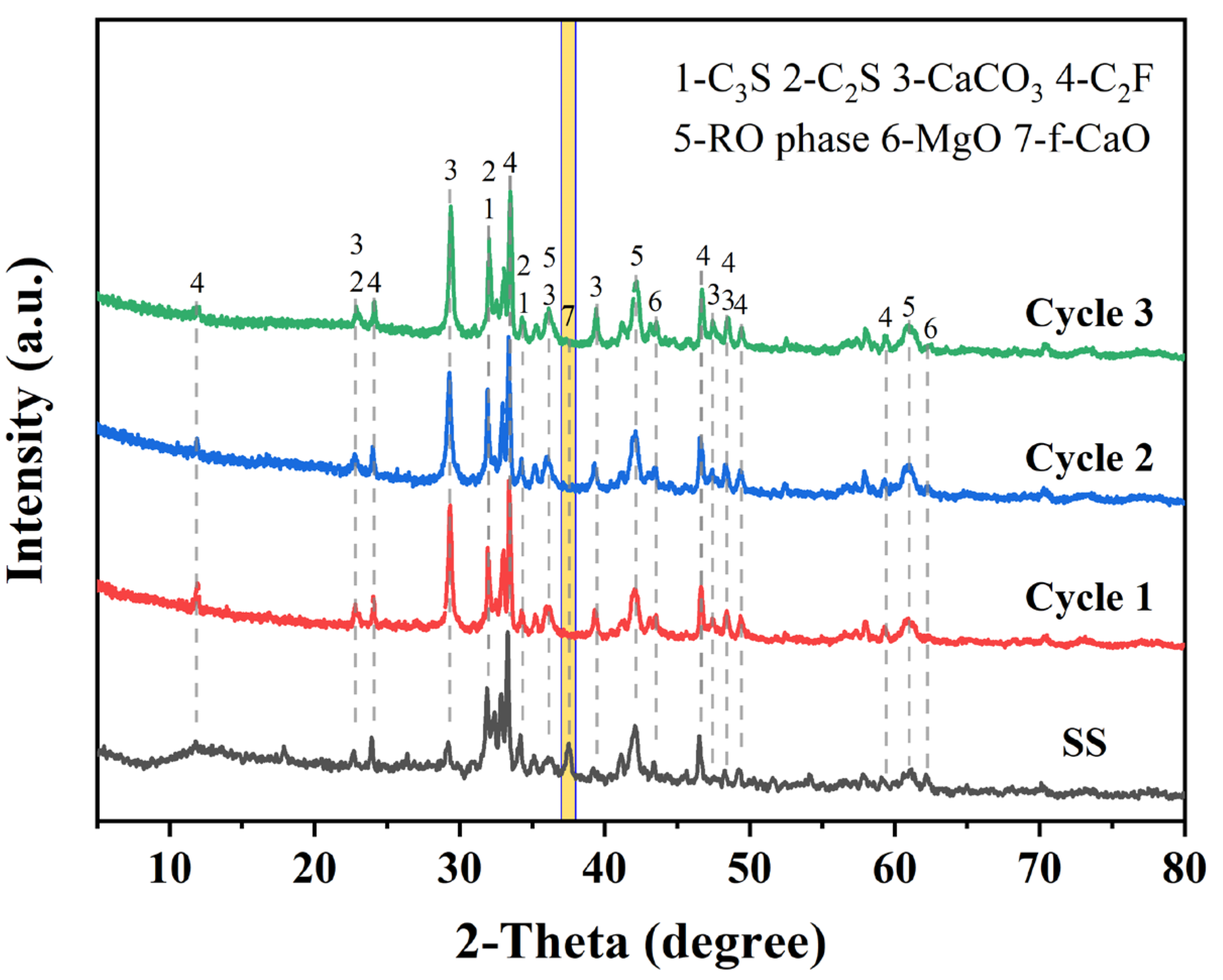
| Sample | Concentration of Glycine (mol/L) | Carbonation Time (h) | Solid–Liquid Ratio |
|---|---|---|---|
| G0CSS-60 | — | 1 | 1:5 |
| G1CSS-60 | 0.05 | 1 | 1:5 |
| G2CSS-60 | 0.1 | 1 | 1:5 |
| G3CSS-60 | 0.25 | 1 | 1:5 |
| G3CSS-30 | 0.25 | 0.5 | 1:5 |
| G3CSS-15 | 0.25 | 0.25 | 1:5 |
| Steps | Reaction NO. | Reactions |
|---|---|---|
| Leaching | 1 | Calcium-bearing mineral phase ↔ Ca2+ + OH− |
| 2 | Calcium-bearing mineral phase + 2NH2CH2COOH ↔ 2NH2CH2COO− + Ca2+ + H2O | |
| Carbonation | 3 | CO2 (aq) + H2O ↔ H2CO3 |
| 4 | H2CO3 + OH− ↔ HCO3− | |
| 5 | HCO3− + OH− ↔ CO32− | |
| 6 | Ca2+ + CO32− ↔ CaCO3↓ | |
| 7 | 2NH2CH2COO− + CO2 ↔ NHCOO−CH2COO− + NH3+ CH2COO− | |
| 8 | NHCOO−CH2COO− + NH3+ CH2COO− + Ca2+ + H2O ↔ CaCO3↓ + 2NH2CH2COOH |
| Sample | CO2 Sequestration | Estimated Mass of CaCO3 Formed |
|---|---|---|
| G3CSS-15 | 3.687 | 8.38 |
| G3CSS-30 | 5.49 | 12.477 |
| G0CSS-60 | 7.189 | 16.339 |
| G1CSS-60 | 7.943 | 18.059 |
| G2CSS-60 | 8.765 | 19.92 |
| G3CSS-60 | 9.42 | 21.409 |
| Sample | Expansion Value (mm) |
|---|---|
| SS | 0.5 |
| G0CSS-60 | 0.17 |
| G1CSS-60 | 0.17 |
| G2CSS-60 | 0 |
| G3CSS-60 | 0 |
Disclaimer/Publisher’s Note: The statements, opinions and data contained in all publications are solely those of the individual author(s) and contributor(s) and not of MDPI and/or the editor(s). MDPI and/or the editor(s) disclaim responsibility for any injury to people or property resulting from any ideas, methods, instructions or products referred to in the content. |
© 2024 by the authors. Licensee MDPI, Basel, Switzerland. This article is an open access article distributed under the terms and conditions of the Creative Commons Attribution (CC BY) license (https://creativecommons.org/licenses/by/4.0/).
Share and Cite
Cao, P.; Zhao, X.; Wang, Y.; Zhang, Z.; Liu, J. Effect of Glycine on the Wet Carbonation of Steel Slag Used as a Cementitious Material. Materials 2024, 17, 451. https://doi.org/10.3390/ma17020451
Cao P, Zhao X, Wang Y, Zhang Z, Liu J. Effect of Glycine on the Wet Carbonation of Steel Slag Used as a Cementitious Material. Materials. 2024; 17(2):451. https://doi.org/10.3390/ma17020451
Chicago/Turabian StyleCao, Peiyu, Xin Zhao, Yutong Wang, Zeyu Zhang, and Jiaxiang Liu. 2024. "Effect of Glycine on the Wet Carbonation of Steel Slag Used as a Cementitious Material" Materials 17, no. 2: 451. https://doi.org/10.3390/ma17020451
APA StyleCao, P., Zhao, X., Wang, Y., Zhang, Z., & Liu, J. (2024). Effect of Glycine on the Wet Carbonation of Steel Slag Used as a Cementitious Material. Materials, 17(2), 451. https://doi.org/10.3390/ma17020451






